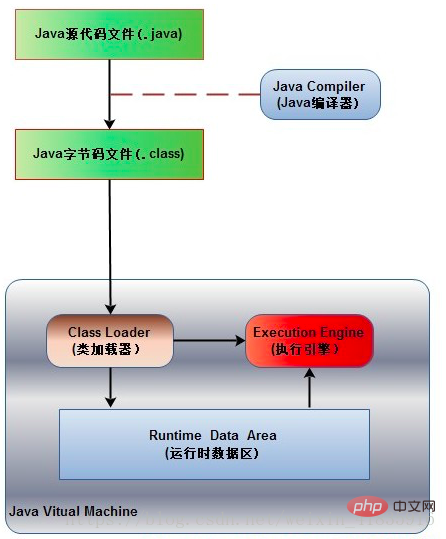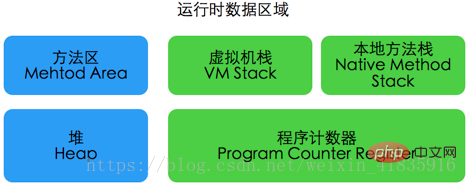Java interview memory model

SF interview question: Do you understand the Java memory model?
360 interview question: Distribution of program memory, five parts
(Learning video sharing: java teaching video)
1. The execution process of the java program

The Java source code file (.java suffix) will be compiled into a bytecode file (.class suffix) by the Java compiler, and then used by the JVM The class loader loads the bytecode files of each class. After the loading is completed, it is handed over to the JVM execution engine for execution. During the entire program execution process, the JVM will use a space to store data and related information needed during program execution. This space is generally called the Runtime Data Area, which is what we often call the JVM. Memory. Therefore, the memory management we often talk about in Java is to manage this space (how to allocate and reclaim memory space).
(Recommendations for more related interview questions: java interview questions and answers)
2. What parts does the runtime data area include:

Method Area:
The method area is a memory area shared by each thread. It is used to store class information, constants, and static information that have been loaded by the virtual machine. Variables, code compiled by just-in-time compiler and other data. When the method area cannot meet the memory allocation requirements, an OutOfMemoryError exception will be thrown.
The method area stores the class version, fields, methods, interfaces and constant pools. The constant pool stores literal and symbolic references. Symbol references include: 1. Fully qualified name of the class, 2. Field names and attributes, 3. Method names and attributes.
JVM Heap (Java Heap):
The Java heap is also a memory area shared by threads. It is created when the virtual machine starts and is managed by the Java virtual machine. The largest piece of memory, mainly used to store object instances. Almost all object instances allocate memory here. Note that the Java heap is the main area managed by the garbage collector, so it is often called the GC heap. If it is in the heap When no memory is available for instance allocation and the heap cannot be expanded, an OutOfMemoryError exception is thrown.
Program Counter Register:
When the bytecode interpreter is working, it selects the next bytecode that needs to be executed by changing the value of this counter. Instructions, branches, loops, jumps, exception handling, thread recovery and other basic functions all need to rely on this counter to complete.
In multi-threading, in order to restore the correct execution position after thread switching, each thread needs to have an independent program counter. Each thread does not affect each other and is stored independently. Therefore, this memory is a thread private.
Virtual machine stack (Java Virtual Machine Stacks):
The Java virtual machine stack is also private to the thread, and its life cycle is the same as the thread. The virtual machine stack describes the memory model of Java method execution: when each method is executed, a stack frame is created to store local variable tables, operand stacks, dynamic linked lists, method exit information, etc. The process from the call to the completion of execution of each method corresponds to the process from pushing a stack frame into the virtual machine stack to popping it out.
Native Method Stacks:
The local method stack belongs to the thread private data area. This part is mainly related to the Native methods used by the virtual machine. Normally, we don't need to care about this area.
(Related recommendations: java introductory tutorial)
The above is the detailed content of Java interview memory model. For more information, please follow other related articles on the PHP Chinese website!

Hot AI Tools

Undresser.AI Undress
AI-powered app for creating realistic nude photos

AI Clothes Remover
Online AI tool for removing clothes from photos.

Undress AI Tool
Undress images for free

Clothoff.io
AI clothes remover

Video Face Swap
Swap faces in any video effortlessly with our completely free AI face swap tool!

Hot Article

Hot Tools

Notepad++7.3.1
Easy-to-use and free code editor

SublimeText3 Chinese version
Chinese version, very easy to use

Zend Studio 13.0.1
Powerful PHP integrated development environment

Dreamweaver CS6
Visual web development tools

SublimeText3 Mac version
God-level code editing software (SublimeText3)

Hot Topics
 1670
1670
 14
14
 1428
1428
 52
52
 1329
1329
 25
25
 1274
1274
 29
29
 1256
1256
 24
24
 PHP: A Key Language for Web Development
Apr 13, 2025 am 12:08 AM
PHP: A Key Language for Web Development
Apr 13, 2025 am 12:08 AM
PHP is a scripting language widely used on the server side, especially suitable for web development. 1.PHP can embed HTML, process HTTP requests and responses, and supports a variety of databases. 2.PHP is used to generate dynamic web content, process form data, access databases, etc., with strong community support and open source resources. 3. PHP is an interpreted language, and the execution process includes lexical analysis, grammatical analysis, compilation and execution. 4.PHP can be combined with MySQL for advanced applications such as user registration systems. 5. When debugging PHP, you can use functions such as error_reporting() and var_dump(). 6. Optimize PHP code to use caching mechanisms, optimize database queries and use built-in functions. 7
 PHP vs. Python: Understanding the Differences
Apr 11, 2025 am 12:15 AM
PHP vs. Python: Understanding the Differences
Apr 11, 2025 am 12:15 AM
PHP and Python each have their own advantages, and the choice should be based on project requirements. 1.PHP is suitable for web development, with simple syntax and high execution efficiency. 2. Python is suitable for data science and machine learning, with concise syntax and rich libraries.
 Break or return from Java 8 stream forEach?
Feb 07, 2025 pm 12:09 PM
Break or return from Java 8 stream forEach?
Feb 07, 2025 pm 12:09 PM
Java 8 introduces the Stream API, providing a powerful and expressive way to process data collections. However, a common question when using Stream is: How to break or return from a forEach operation? Traditional loops allow for early interruption or return, but Stream's forEach method does not directly support this method. This article will explain the reasons and explore alternative methods for implementing premature termination in Stream processing systems. Further reading: Java Stream API improvements Understand Stream forEach The forEach method is a terminal operation that performs one operation on each element in the Stream. Its design intention is
 PHP vs. Other Languages: A Comparison
Apr 13, 2025 am 12:19 AM
PHP vs. Other Languages: A Comparison
Apr 13, 2025 am 12:19 AM
PHP is suitable for web development, especially in rapid development and processing dynamic content, but is not good at data science and enterprise-level applications. Compared with Python, PHP has more advantages in web development, but is not as good as Python in the field of data science; compared with Java, PHP performs worse in enterprise-level applications, but is more flexible in web development; compared with JavaScript, PHP is more concise in back-end development, but is not as good as JavaScript in front-end development.
 PHP vs. Python: Core Features and Functionality
Apr 13, 2025 am 12:16 AM
PHP vs. Python: Core Features and Functionality
Apr 13, 2025 am 12:16 AM
PHP and Python each have their own advantages and are suitable for different scenarios. 1.PHP is suitable for web development and provides built-in web servers and rich function libraries. 2. Python is suitable for data science and machine learning, with concise syntax and a powerful standard library. When choosing, it should be decided based on project requirements.
 PHP's Impact: Web Development and Beyond
Apr 18, 2025 am 12:10 AM
PHP's Impact: Web Development and Beyond
Apr 18, 2025 am 12:10 AM
PHPhassignificantlyimpactedwebdevelopmentandextendsbeyondit.1)ItpowersmajorplatformslikeWordPressandexcelsindatabaseinteractions.2)PHP'sadaptabilityallowsittoscaleforlargeapplicationsusingframeworkslikeLaravel.3)Beyondweb,PHPisusedincommand-linescrip
 PHP: The Foundation of Many Websites
Apr 13, 2025 am 12:07 AM
PHP: The Foundation of Many Websites
Apr 13, 2025 am 12:07 AM
The reasons why PHP is the preferred technology stack for many websites include its ease of use, strong community support, and widespread use. 1) Easy to learn and use, suitable for beginners. 2) Have a huge developer community and rich resources. 3) Widely used in WordPress, Drupal and other platforms. 4) Integrate tightly with web servers to simplify development deployment.
 PHP vs. Python: Use Cases and Applications
Apr 17, 2025 am 12:23 AM
PHP vs. Python: Use Cases and Applications
Apr 17, 2025 am 12:23 AM
PHP is suitable for web development and content management systems, and Python is suitable for data science, machine learning and automation scripts. 1.PHP performs well in building fast and scalable websites and applications and is commonly used in CMS such as WordPress. 2. Python has performed outstandingly in the fields of data science and machine learning, with rich libraries such as NumPy and TensorFlow.




